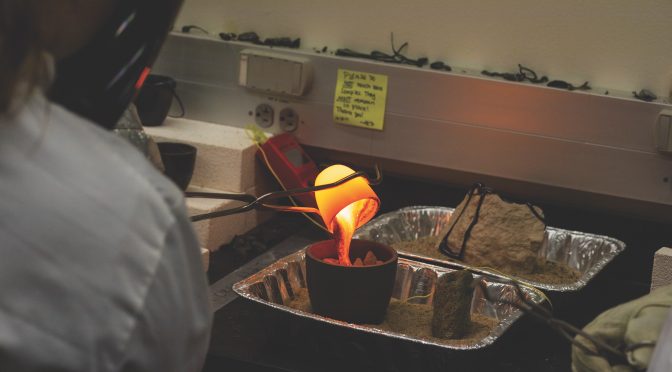When Alison Graettinger, Ph.D., says she’s a volcanologist, most people picture massive structures in exotic places, like Mount Kilauea in Hawaii or Mount Vesuvius in Italy.
Graettinger, however, spends a lot more time looking at the ground than she does at the sky. Her area of expertise is studying Maar volcanos — broad, crater-like types that form when magma comes into contact with groundwater, often exploding before it ever reaches the surface.
In short, she spends a lot of time looking at holes.
Graettinger estimates she’s spent thousands of hours looking at various photos and satellite images, trying to determine whether they show simple craters or evidence of Maar volcanic activity, even if it occurred thousands of years ago.
In addition to meticulously cataloguing various craters, Graettinger also spends research time out in the field, either examining Maar volcanoes or trying to recreate them.
This sometimes involves enduring heat, rain, bugs and long hikes to reach her version of the promised land: a crater or body of water that may have once been a Maar volcano. Other times it means digging a hole, filling it with dynamite and ping pong balls, then watching it detonate and recording where everything lands when the dust settles.
Though Graettinger spends more time digging holes than summiting volcanoes, the ultimate goal of her research is to help the people who do spend time on and around those potentially dangerous sites. When it comes to how lava interacts with water and the explosions that sometimes follow, geologists have a lot more questions than answers. Graettinger’s expertise can help researchers create an action plan for a specific volcano and how things could progress if it erupted.
That plan looks something like a tree, mapping all the different things that could occur, then what could occur next, and so on. In the event of an eruption, that detailed plan can save precious minutes and hours, and help officials determine how best to protect the people nearby.
It’s a thought that Graettinger and her colleagues wrestled with while they were attending a conference in Italy.
“We had to ask ourselves, ‘How do we deal with the fact that we’re all currently sitting in an active volcano surrounded by 3 million people. What if it erupted? How much time do you need to get them out, and what science do you need to do that?’”
That’s where Graettinger comes in.
Volcanology: Not just as seen on TV
Technically, Graettinger’s journey to volcanology began when she was getting her undergraduate degree from the University of Puget Sound in Tacoma, Washington. Non-technically, though, it began when she was an adventurous kid growing up in Reno, Nevada.
“I was a muddy, dirty child. I went into caves — my brother would send me first,” she says. “I was going to be a veterinarian, as all small children are, and my mom would tell me things like, ‘You know, they need veterinarians on the moon!’ She always wanted me to push higher.”
Eventually, Graettinger’s love of science and the outdoors took her to the University of Puget Sound in Tacoma, Washington, as a geology major.
As she prepared to graduate with her undergraduate degree, she knew she wanted to go to graduate school. She compiled a list of programs that all revolved around petrology — things like crystals and chemistry that, today, help her inform the magma part of her research — and brought them to her professor.
The professor, though, responded with two sentences that profoundly changed the trajectory of her career: “I have to be honest with you, I don’t think that’s what you want. You want to study volcanoes.”
At 20, Alison’s response was, “You can do that?” She could see Mount Rainier from campus and, judging by her professor’s response, clearly had an interest in volcanology, but, as she puts it, “I just assumed that was a thing you only did on TV.”
Her professor’s suggestion, though, was all she needed to make her decision. “It was as simple as that — having somebody who paid attention and knew something more than I did,” she says. “I ran with it.”
From there, she was off to the University of Waikato in New Zealand to earn her master’s. There, she got her first real experience with volcanology, climbing a mountain with one of her professors. After hours spent hiking through the rain, and somewhat to the confusion of her professor, she described the day as “a dream.”
“What’s some rain? I’m on the side of a volcano, I’m in New Zealand. My brain was just exploding at the time,” she says. “We were in terrible conditions, but I was just that jazzed.”
It was clear she had found her niche. After New Zealand, it was on to the University of Pittsburgh to earn her doctorate, four years of post-doctoral work at the University of Buffalo and, finally, to UMKC to serve as an assistant professor in the Department of Earth and Environmental Sciences.
The world meets at UMKC
That first exposure to volcanology has taken Graettinger from New Zealand to Kansas City to, somewhat literally, Mars. Using her expertise from examining thousands of potential Maar volcanoes, Graettinger created a set of guidelines to help other scientists make their own identifications.
Those guidelines are being used to identify volcanoes not just here on Earth, but also in space. Scientists at NASA are using Graettinger’s data to examine potential Maar activity on Mars. Since Maar volcanoes require water to form, their presence would indicate that water exists on Mars, even if buried deep below the surface. Other researchers are using her research to look for Maar volcanoes on one of Saturn’s moons, Titan.
Back on Earth, Graettinger’s field work takes her around the world — to Iceland, Chile, France, Spain and Italy, just in recent memory — but also across the United States. This summer alone, she traveled to South Dakota, Montana, Wyoming, Idaho and Oregon, examining volcanic sites of all shapes and kinds.
Her work has been supported by government and nonprofit groups like the National Science Foundation and the Geological Society of America, as well as the University of Missouri Research Board and the UMKC Funding for Excellence Program. She also collaborates with researchers from the University of Buffalo in New York, which houses the Center for Geohazards Studies, as well as Yamagata University in Japan and the University of California, Davis.
When she’s not traveling the globe, she’s using her lab in Flarsheim Hall to simulate the reactions she observes in the field.
In a small, dark room on the fourth floor sits a furnace that can reach temperatures of 2,900 degrees Fahrenheit. Graettinger uses it to re-melt lava from around the world, creating “small pours” to examine two things: how well the sample melts (and therefore, whether it can be used in a field experiment) and how it mixes with sediment (the loose material magma encounters as it approaches ground level).
That information can help inform the larger experiments Graettinger performs in the field, trying to answer questions like, “What happens if you blow something up in layered ground? What happens if you move it up, move it down, do a whole bunch, do them close together in time, move them side-to-side? What can we do here in the field to compare to the natural world?”
The beauty of Graettinger’s research is that she can conduct her experiments anywhere — from a field in Buffalo to a lab in Flarsheim to the Quad in the middle of campus. Her “trash-cano” demonstration is a particular favorite among students, probably because it involves an explosion, but also because it allows them to apply what they’ve learned in the classroom to a real-world experiment.
Students take an active role in Graettinger’s research, too — assisting on lava pours, poring over satellite images of craters, even traveling with her to help collect data in the field. It’s important, Graettinger says, that students be able to ask questions and make their own discoveries, no matter how small.
“It’s just fun to watch them, when they say, ‘Wait, you mean nobody’s done this before? I’m the first? I get to answer this when nobody had an answer before?’ That’s an important part of learning,” Graettinger says. “And even if you don’t become a researcher, just knowing that not everything has been done and there are still problems to solve – that’s a critical part of education.”

